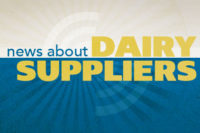More cheese, less carbon
Chr. Hansen's cheese coagulant is said to reduce carbon footprint
Chy-Max M can 'significantly' cut CO2 emissions, says the ingredient supplier.

The following information was prepared by Chr. Hansen
Reducing the carbon footprint in the food value chain—the greenhouse gas emissions from farm to fork—is a major focus area for modern food manufacturers, and many companies have Corporate Social Responsibility/sustainability (CSR) targets and actions in place to reduce their environmental impact.
 According to the Food and Agriculture Organization of the United Nations, the food sector contributes over 20% of global greenhouse gas emissions. Cheese ranks among the top 10 foods in terms of value chain carbon footprint – mostly due to the milk intake which has a footprint of 1.1 ton CO2 per ton of milk.
According to the Food and Agriculture Organization of the United Nations, the food sector contributes over 20% of global greenhouse gas emissions. Cheese ranks among the top 10 foods in terms of value chain carbon footprint – mostly due to the milk intake which has a footprint of 1.1 ton CO2 per ton of milk.
Collectively, dairies around the world produce more than 20,000,000 tons of cheese a year, according to the U.S. Dairy Export Council). Chr. Hansen calculates that if all cheese makers converted to using its Chy-Max M as their cheese coagulant, the result would be a total CO2 reduction of at least 1,250,000 tons of CO2, equaling the yearly greenhouse gas emissions from more than 83,000 Western European households.
Chy-Max M means increased cheese yield because cheesemakers use less milk to produce the same amount of cheese, compared to other types of coagulant. Exactly how big a yield increase and C02 reduction depends on the type of cheese.
To be specific, going from Chy-Max or another first generation fermentation-produced chymosin (FPC) to Chy-Max M will give a 22 to 54 kilogram of CO2 per ton of cheese reduction of the carbon footprint due to the proven yield increase. The shift from a microbial coagulant will save 39 to 146 kilogram of CO2 per ton of cheese, while moving from animal rennet to Chy-Max M will cut CO2 emissions by 38 to 70 kilogram per ton of cheese. Today, approx. 20% of all cheese is produced with animal rennet, 30% with microbial coagulant and 50% with FPC.
The mozzarella cheese example
For instance, an average producer of mozzarella cheese producing 20,000 tons of cheese per year who switches to Chy-Max M could save 1,200 to 1,500 tons of CO2 each year depending on the type of coagulant the producer uses today.
Rolando Saltini, Coagulants Marketing Manager, said the company offers a "CO2 calculator" for dairy customers who wish to get an overview of CO2 emissions associated with producing cheese with the different types of coagulants.
Looking for a reprint of this article?
From high-res PDFs to custom plaques, order your copy today!






